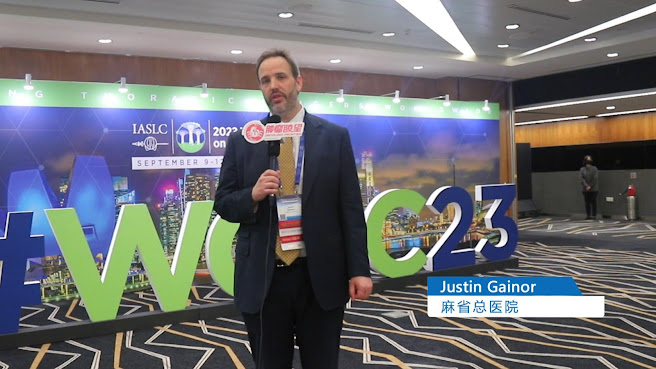WCLC 2023 |Dr. Gainor reviews IMpower151: Is the high percentage of patients with EGFR mutations, the reason for the research’s failure ?
Dr. Justin
Gainor
interviewed by Oncology Frontier at the 2023 WCLC conference.
Oncology Frontier: Please introduce yourself,including your name,
profession and where are you from?
Dr. Gainor: Hi. My name is Dr. Justin Gainor. I am a thoracic medical oncologist at the Massachusetts General Hospital and Harvard Medical School.
Oncology Frontier: The new analysis of Phase III IMpower151 study was presented at 2023 WCLC, how would you comment on the efficacy and safety of Atezolizumab + Bevacizumab + Chemotherapy in 1L Metastatic Nonsquamous NSCLC?
Dr. Gainor: IMpower151 really follows on the heels of IMpower150, and it is important to distinguish between the two studies. IMpower150 was a randomized phase III study which compared carboplatin/paclitaxel/bevacizumab +/- atezolizumab, and that was a positive study with respect to both progression-free survival and overall survival. IMpower151 was different in several aspects. First, it was a study that compared carboplatin + pemetrexed or paclitaxel (although most patients received pemetrexed) + bevacizumab +/- atezolizumab. This study enrolled about 300 patients and was done exclusively in China, whereas IMpower150 was a global study. The primary endpoint was progression-free survival. Unfortunately, it was a negative study. The quadruplet regimen did not lead to an improvement in progression-free survival. I think part of that was driven by a very proportion of patients with EGFR mutations - more than 50% of patients enrolled in the study actually had EGFR mutations. We know that those patients don’t derive as much benefit from PD-1 pathway blockade, and I suspect that is one primary reason why we are not seeing a benefit.
Oncology Frontier: Patients with advanced non–small cell lung cancer (NSCLC) may be able to stop receiving immunotherapy at 2 years or continue ICI indefinitely after 2 years. Which of the two options do you think is better?
Dr. Gainor: We
don't have a lot of randomized data to guide our decision-making there. All of
the pivotal phase III studies that were done examining PD-1 pathway inhibitors
for the most part stopped after two years. There is one study that was done
with nivolumab where it randomized patients at one year to stop therapy or
continue. In that study, there was benefit to patients who continued beyond one
year, It was an exploratory analysis; it wasn't the primary endpoint. So it
looks like continuing beyond one year is better, but what happens at two years,
we don't know. In my own practice, I generally have a discussion with patients
at the two-year mark, and if they are having a very significant response to
therapy without much disease present, I will generally stop.
Oncology Frontier: Based on the findings of the current studies, is there a difference in the efficacy of PD-1 inhibitors and PD-L1 inhibitors in extensive-stage small-cell lung cancer?
Dr. Gainor: I take
a step back even more and just say, is there a big difference between PD-1 and
PD-L1 inhibitors? I would say, not much. Early on, when these drugs were being
developed, there was consideration that perhaps PD-L1 inhibitors would have a
better toxicity profile, but that really hasn’t emerged - it is very minimal.
In small cell lung cancer specifically, I don't think there is a big difference
when it comes to efficacy between PD-1 and PD-L1 inhibitors. We know that
durvalumab and atezolizumab have positive phase III data, but at the same time,
pembrolizumab has a negative study, despite all of its positive studies in the
non-small cell lung cancer space. So ultimately, I think these inhibitors are a
lot more similar than they are different.
